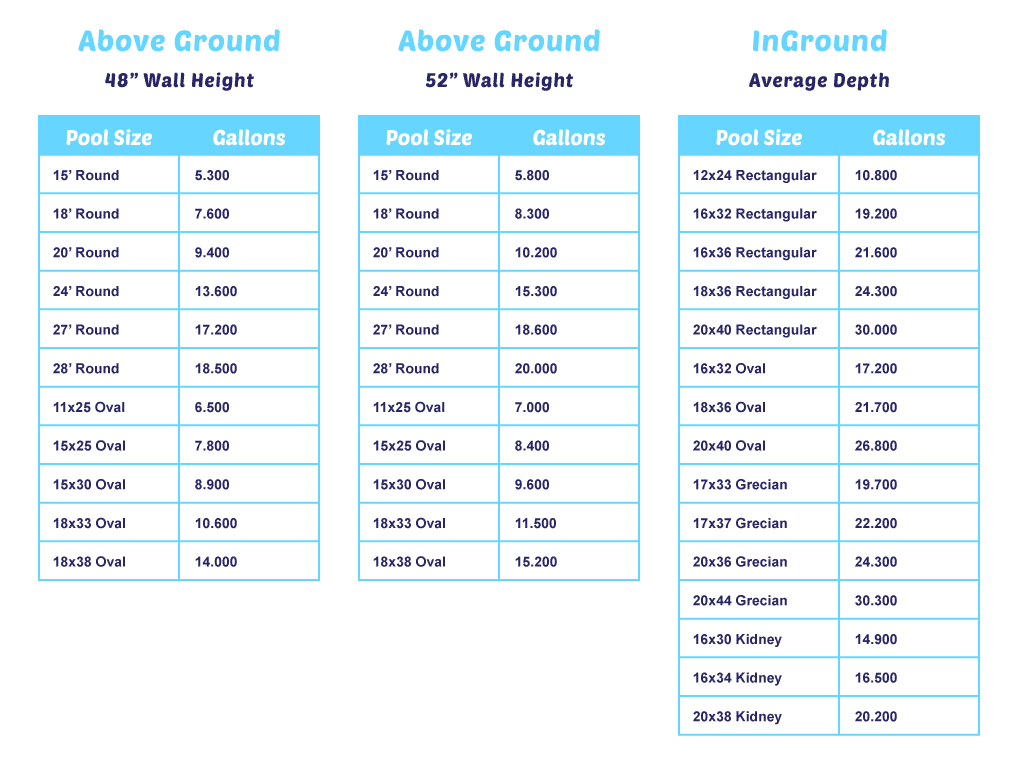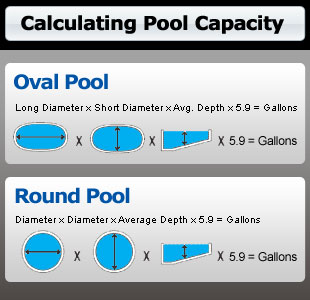How to Calculate Cubic Feet of a Round Pool
2 days agoTo add a generator to a gas system you have to make sure you do not starve the other appliances. After this find the product of that figure by 75 to calculate the volume of the pool in gallons.

How To Calculate The Volume Of A Circular Pool Or Cylinder Youtube
Please enter a value.

. Measure the length and width of both sections and add the square footages using step 1. Square footage of the pool area square footage of the slab area around the pool perimeter of outer area lineal feet concrete needed in cubic yards concrete needed in cubic metres. Multiplier 59 for Round or Oval pools.
Often the sizes can be modified for emergency use. Estimating the volume of your pool is one of the first steps of being able to determine the accurate amount of corrective chemicals needed for a given situation. The diameter of the pool length A in feet the diameter of the overall area length B in feet depth of concrete slab inches Results.
Here is a resource to help you and to convert units into those most useful to you. Please enter a value. Once you have calculated the volume of your pool in cubic feet simply multiply it by 748 and the answer is the number of gallons of water your pool holds.
That will give you the volume in square feet. To calculate the volume of a round pool again multiply the surface area as described above then multiply it times the depth. To calculate the volume or capacity of an item or space in cubic feet you will first need to measure its length width and height in either feet inches or a combo of both centimeters meters or yards.
In the example 25 feet squared times 314. Please enter a value. 122 6ft average depth.
Deep End 10ft 2ft 10ft 12ft. That would fill approximately 300 wheelbarrows. 4026 cubic feet x 748 30114 gallons.
1 2. The 20-foot diameter pool had a surface area of 314 square feet. Multiply the average depth the average width and the length of the pool.
Outlet A supplying 32 cubic feet per hour requires ½ inch pipe. To get the average depth of your pool add the shallow end depth and deep end depth then divide by 2. Then use the calculator to convert this figure into litres imperial gallons or US gallons.
Lets say the length of the pool is 40 feet. In the example 5 feet times 5 feet equals 25 feet squared. As mains water is supplied in Britain in cubic metres start by measuring in metres to obtain an answer in cubic metres.
With that information use the following formula to calculate the sand volume in yards. For example an L shaped cabinet designed to fit the corner of a room could be dealt with as two different. Pi 314 times radius squared.
Then multiply by 75 because there are. 1677 cubic feet of dirt is about 62 cubic yards. So 55 feet x 183 feet x 40 feet 4026 cubic feet.
This is just half the distance from one side of the pool to the other. Multiplying that by the depth gives the volume in cubic meters. Length x width x depth x 75 volume in gallons Length times width gives the surface area of the pool.
Add them together and divide by two 2. Multiply the number calculated in Step 3 by pi to determine the area of the pool. How to calculate cubic feet.
For a round pool with a radius of 5 feet youd need at least 049 cubic yards of sand for the base. Total Volume Surface Area x Depth. The above calculation is fairly accurate if.
Length feet x Width feet x Height feet Volume in cubic feet written as Xft3 If the shape is irregular mentally divide it into regular shapes and calculate the volume for each part separately before adding them all together. Multiply this number by average depth to calculate the volume in cubic feet. If your pool is 32 feet long 16 feet wide and has an average depth of 6 feet then.
There are 75 gallons in each cubic foot which is why you multiple the last number by 75. If you have ever struggled trying to keep your pool chemically balanced you know the importance of the pool volume. To determine the average depth in a pool where the bottom slopes measure the shallow end the deep end depth.
If one section is 12-by-10-feet and the other is 12-by-10-feet the result will be 120 plus 120 square feet equals 240 square feet. Volume 314 x r 2 x depth x 0037. Multiply the radius by itself.
Calculating the average depth of your pool is not easy because most pools have a shallow end and a deep end with a slope in between. Please fill in all areas below entering. For example if the shallow end is 4 ft and deep end is.
Then multiply that by the average depth. One cubic foot of water equals 748 US gallons. Round is one of the most popular pool shapes and to find out the.
If this pool is 4 feet deep the volume would be 1256 cubic feet. For example if your pool measures an 75 foot radius with a 2-foot wide. 16775 Cubic Feet is the estimated total volume of this pool.
Multiply the result by 748 to get the answer in gallons. 3 Using the length in feet column row marked 60 feet in Table 2. Once you have those measurements you apply some multiplication as follows.
Type in the length width and average depth of your pool into the boxes below and click on the calculate button and the volume of your pool in cubic metres and gallons will be displayed. If youd like to find the pool volume in gallons multiply your results by 75 as there are 75 gallons for each cubic foot. Calculate the square footage of a L-shaped pool by dividing the pool into two rectangular or square sections.
Pi is generally estimated as 314. Cubic feet is a unit of volume. Shallow End 2ft.
Determine the Average Depth. Please enter a value. The pool volume calculator uses the following formulas.
This is a simple calculation once youve worked out the volume of your pool in cubic feet. Choose Your Pool Shape.
![]()
How To Measure Surface Area Of Swimming Pool

How To Calculate The Volume Of Your Swimming Pool


Comments
Post a Comment